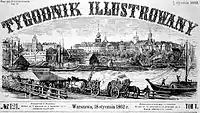Tygodnik Illustrowany
Tygodnik Illustrowany (Polish: [tɨˈɡɔdɲik ilustrɔˈvanɨ], The Illustrated Weekly) was a Polish language weekly magazine published in Warsaw from 1859 to 1939.[1] The magazine focus was on literary, artistic and social issues.[2]
 Tygodnik Illustrowany no. 121 (1862) | |
| Type | weekly magazine |
|---|---|
| Founder(s) | Józef Unger |
| Publisher | Gebethner i Wolff |
| Language | Polish language |
History
It is said to have been one of the most important and popular Polish magazines of the period,[1][3] profitable and widely respected.[4] It was particularly popular among the inteligencja social group.[5] It was the oldest cultural periodical published in Warsaw.[6]
The magazine was first published by Józef Unger; later it was taken over by the company Gebether i Wolff.[7] Editors included: Ludwik Jenike, Józef Wolff, Artur Oppman, Adam Grzymała-Siedlecki, Zdzisław Dębicki, Piotr Choynowski, W. Gebethner, Jan Robert Gebethner, W. Czarski and C. Staszewicz.[7] In 1909 its circulation was reported to be about 20,000.[8]
The magazine commonly published articles on history of Poland and Polish society, including archeological, ethnographic and similar essays.[3] It also published texts on the progress of technology and on voyages and explorations.[5] It serialized some novels, including Eliza Orzeszkowa's Nad Niemnem, Władysław Reymont's Chłopi Stefan Żeromski's Popioły.[5] Texts published in it are still seen as high quality.[3]
The magazine history ends with the German invasion of Poland in September 1939; the last issue was published on 3 September that year.[4]
Among its contributors most prominent were Polish literary figures such as Józef Ignacy Kraszewski, Eliza Orzeszkowa, Bolesław Prus and Nobel Prize winner Henryk Sienkiewicz.[1] Others included: Tadeusz Boy-Żeleński, Władysław Skoczylas,[5] Władysław Sabowski, Jan Zachariasiewicz, Zygmunt Miłkowski, P. Chmielewski, Wojciech Bogusławski, Marian Gawalewicz, Józef Wieniawski.[7]
It is credited with popularizing woodcut illustrations in Poland, publishing works by artists such as Wojciech Gerson, Henryk Pillati, Franciszek Kostrzewski and Juliusz Kossak.[1]
References
- HALINA LERSKI (30 January 1996). Historical Dictionary of Poland, 966-1945. ABC-CLIO. pp. 615–616. ISBN 978-0-313-03456-5. Retrieved 23 May 2013.
- Anna Agnieszka Szablowska; Мар'яна Сеньків; Музей етнографії та художнього промислу Інституту народознавства НАН України (2009). Plakat polski: ze zbiorów Muzeum Etnografii i Przemysłu Artystycznego Instytutu Narodoznawstwa Narodowej Akademii Nauk Ukrainy we Lwowie. Ministerstwo Kultury i Dziedzictwa Narodowego. p. 72. ISBN 978-83-929227-1-1. Retrieved 23 May 2013.
- "Opis realizacji projektu". Bilp.uw.edu.pl. Retrieved 2014-04-04.
- Alina Brodzka (1992). Słownik literatury polskiej XX wieku. Ossolineum. p. 1339. ISBN 978-83-04-03942-1. Retrieved 23 May 2013.
- "Encyklopedie w INTERIA.PL - największa w Polsce encyklopedia internetowa". Encyklopedia.interia.pl. Retrieved 2014-04-04.
- Stanisław Bylina (1978). Stosunki literackie polsko-czeskie i polsko-słowackie, 1890-1939: praca. Zakład Narodowy im. Ossolińskich. p. 98. Retrieved 23 May 2013.
- "Tygodnik Illustrowany - Przyjaciel Ludu - WIEM, darmowa encyklopedia". Portalwiedzy.onet.pl. Retrieved 2014-04-04.
- Alina Brodzka (1992). Słownik literatury polskiej XX wieku. Ossolineum. p. 130. ISBN 978-83-04-03942-1. Retrieved 23 May 2013.